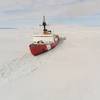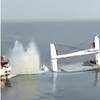ABS: Technical Guidance For Ice Class Tankers
The guide is an outgrowth from ABS’ work with the principal Asian shipyards developing new aframax ice class tanker designs in response to the increased traffic in the Baltic. Growing oil exports from the Russian port of Primorsk and Sakhalin have prompted a marked increase in the number of new tankers on order with ice strengthening to allow more flexible trading. Additionally, operators are taking into consideration the 2010 IMO imposed single hull phase-out deadline as they renew their aframax fleets.
“The FEA Guide allows us to perform direct calculations for developing alternative structural arrangements that are more producible than those developed from the prescriptive rules,” says Akira Akiyama, Vice President, Technology & Business Development, ABS Pacific.
These direct calculation methodologies help ABS to identify the simplest structural arrangements and optimal horsepower to meet the most stringent ice class requirements. “In the case of machinery output, credit can be given for increasing propeller performance and reducing ice resistance. In the case of the latter, ABS provides guidance on model tests to determine powering requirements,” he adds.
“For a typical aframax tanker the percentage of steel weight increases by as much as 16 percent for a Finnish Ice Class 1A Super or ABS notation equivalent of 1AA,” Akiyama points out. “Both owners and yards are looking to the classification societies to help them meet these requirements in the most cost effective manner without compromising the structural and operational capability of the vessel.”
ABS ice class requirements are incorporated into its Steel Vessel Rules. The notations indicate the thickness and severity of the ice conditions for which the vessel has been designed and built.
“Although reinforcement in the bow design is a primary concern, there are technical considerations for the entire hull,” says Akiyama. “The midbody and aft areas must be considered and the form of the hull must handle the ice-strengthened propulsion requirements and also handle compressive ice pressure if the vessel becomes trapped.”
By analyzing such factors as the period and severity of the expected ice conditions for specified areas of operation, including the presence of multi-year ice, ABS can provide valuable input to an owner’s decision making when selecting the most suitable ice class for a newbuilding.
ABS offers detailed data on maximum ice conditions within the considered region of navigation, ice propulsion analysis with supporting model and full-scale test data, ice load definition, stress analysis of ship structures due to the ice loads and safe speed determinations for navigation under differing ice conditions.
“Applied technology and practical experience are allowing us to constantly refine our ice strengthening rule requirements,” says ABS Chief Technology Officer, Christopher J. Wiernicki. “We have developed direct calculation methodologies for structure and machinery output that allow for alternatives to the prescribed Finnish-Swedish Ice Class Rules, as permitted by the Rules, without compromising safety equivalency. And we have developed a risk management module to the ABS SafeShip program that can be used by owners, and by ABS, to assess the total risks of a cold weather operational profile.”
Although there is a lot of attention being paid to the new generation of ice class tankers, the technology is also applicable to many other vessels, from containerships trading year-round into Montreal, to drill barges in the Caspian Sea, to the new generation of LNG carriers and the ABS-classed drilling and production unit in service off Sakhalin.
The three key requirements in assessing the ability of a ship to navigate in ice are power, strength and prediction of the ice loads. ABS points out the importance of understanding the differing characteristics of multi-year ice and first-year ice, and of the four basic forms of ice - solid, consolidated, brash or pack. Each has different properties and requires specific technical guidance and different class notations.
According to Clarkson Research Studies, there are currently 137 vessels on order with ice strengthening and of these 65 are to be constructed to ice class 1A. The ice class fleet is expected to grow by 9 percent in 2004, 12 percent in 2005 and 33 percent in 2006, predicts Clarkson.












